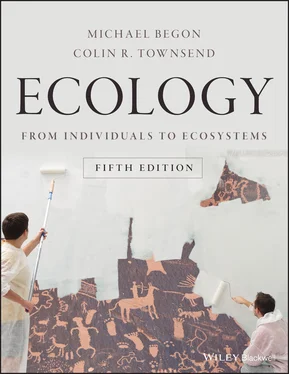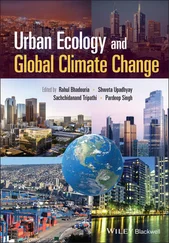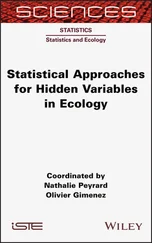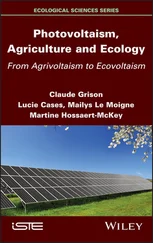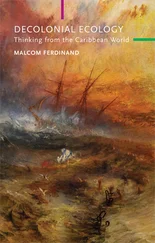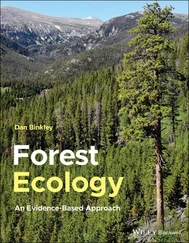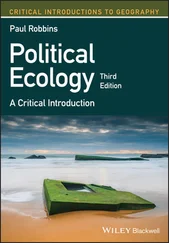The most profound effect of anthropogenic CO 2emissions, global warming, is dealt with in the next section. In addition, ocean acidification is another worrying consequence.
ocean acidification
A large proportion of anthropogenic CO 2is absorbed by the oceans, thus far reducing seawater pH by 0.1 units since the Industrial Revolution (equivalent to a 30% increase in acidity) as well as reducing carbonate ion concentrations. We have already seen that pH is a condition with significant influences on the success of organisms, but the fact that many parts of the ocean are also becoming undersaturated with calcium carbonate minerals is expected to have profound consequences for calcifying species such as corals, molluscs, sea urchins and calcareous plankton. On the other hand, photosynthetic production in the oceans is likely to benefit from higher CO 2concentrations.
We started this chapter discussing temperature, moved through a number of other environmental conditions to pollutants, and now return to temperature because of the effects of those pollutants on global temperatures. The globally averaged combined land and ocean surface temperature has increased by about 0.85°C from 1880 to 2012 ( Figure 2.28a). We have already witnessed melting of arctic ice and rises in sea level ( Figure 2.28b) (related to thermal expansion and the input of ice meltwater) and can expect further melting of the ice caps, a consequent rising of sea level and significant shifts in the pattern of global climates and changes to the distribution of species.

Figure 2.28 Annual land and ocean surface temperature anomalies and sea‐level changes.(a) Globally averaged combined annual land and ocean surface temperature anomalies from 1850 relative to the average over the period 1986–2005. Colours indicate different datasets. (b) Globally averaged annual sea‐level changes from 1900 relative to the average over the period 1986–2005. Colours indicate different datasets that have been aligned to have the same value in 1993. Uncertainties are indicated by shading.
Source : IPCC (2014).
Predictions of the extent of global warming resulting from the enhanced greenhouse effect come from two sources: (i) trends detected in measured datasets, including the width of tree rings, sea‐level records and measures of the rate of retreat of glaciers; and (ii) predictions based on sophisticated computer models that simulate the world’s climate according to a variety of possible mitigation scenarios. The latter range from the best case, where there is a concerted and international political drive to minimise the temperature rise by the use and development of efficient technologies (e.g. switching to renewable energy and bioenergy, carbon capture and geological storage) to the worst case where very little is done and the expected outcome is close to the no‐mitigation baseline scenario.
global distribution of climate change
Global warming so far has not been evenly distributed over the surface of the earth, and neither will it be in the future. Northern high latitudes are expected to change more rapidly than the tropics, land areas will change more rapidly than the oceans, and small islands and coastal regions will be particularly prone to associated rises in sea level.
We have emphasised how the distributions of species are strongly influenced by temperature and water availability, and how many organisms are impacted by occasional extremes rather than by average conditions. Computer modelled projections imply that global climatic change will also bring greater variance in temperature, rainfall, hurricanes and so on. Hence, not only the predicted average climate changes, but also the increased frequency and severity of extremes, are certain to be accompanied by marked responses in the distribution of species and biomes.
can the biota keep up with the pace?
Global temperatures have changed naturally in the past, as we have seen. We are currently approaching the end of one of the warming periods that started around 20 000 years ago, during which global temperatures have risen by about 8°C. The greenhouse effect adds to global warming at a time when temperatures are already higher than they have been for 400 000 years. Buried pollen provides evidence that North American forest boundaries have migrated north at rates of 100–500 m year −1since the last ice age. However, this rate of advance has not been fast enough to keep pace with postglacial warming. The rate of warming forecast to result from the greenhouse effect is 50–100 times faster than postglacial warming. Thus, of all the types of environmental pollution caused by human activities, none may have such profound effects as global warming. We must expect latitudinal and altitudinal changes to species’ distributions and widespread extinctions as floras and faunas fail to track and keep up with the rate of change in global temperatures. What is more, large tracts of land over which vegetation might advance and retreat have been fragmented in the process of civilisation, putting major barriers in the way of vegetational advance. It will be very surprising if many species do not get lost on the journey.
The ecological implications of greenhouse gas emissions are profound indeed for the spread of pest species, for future conservation and restoration management, and for the production of wild fisheries, agriculture and aquaculture. These topics will crop up throughout the book, but especially in its final chapter.

Chapter 3 Resources
3.1 Introduction
According to Tilman (1982), all things consumed by an organism are resources for it. But consumed does not simply mean ‘eaten’. Bees and squirrels do not eat holes, but a hole that is occupied is no longer available to another bee or squirrel. Similarly, females that have already mated may be unavailable to other mates. All these things have been consumed in the sense that their stock or supply can be reduced by the activities of the organisms concerned.
autotrophs and heterotrophs
There is a fundamental distinction between autotrophic and heterotrophic organisms. Autotrophs assimilate simple inorganic resources into packages of organic molecules (proteins, carbohydrates, etc.). These become the resources for the heterotrophs (decomposers, parasites, predators and grazers), which take part in a chain of events in which each consumer of a resource becomes, in turn, a resource for another consumer. At each link in this food chain, the most obvious distinction is between saprotrophs and predators . Saprotrophs – bacteria, fungi and detritivorous animals (see Chapter 11) – use other organisms as food but only after they have died, or they consume another organism’s waste or secretory products. Predators, defined broadly, feed on other living organisms, or parts of other living organisms (see Section 3.7).
photoautotrophs and chemoautotrophs
Autotrophs may themselves be divided into photoautotrophs and chemoautotrophs . The photoautotrophs – green plants and algae, and photosynthetic protists and bacteria – utilise solar radiation, carbon dioxide (CO 2), water and mineral nutrients as resources. Through photosynthesis, they use the radiation as a source of energy to reduce CO 2to obtain the organic compounds and energy that they need for growth and reproduction. Directly or indirectly, photosynthesis is the source of all energy in terrestrial and most aquatic ecosystems. Its evolution has led to the current 21% levels of oxygen in the atmosphere, driving down the levels of CO 2. By contrast, chemoautotrophs – certain bacteria and archaea – use chemical energy from the oxidation of inorganic substances such as hydrogen sulphide, elemental sulphur, ferrous iron or ammonia to reduce CO 2and so obtain the organic compounds and energy that they need. They typically live in ‘extreme’ environments such as hot springs and deep‐sea vents.
Читать дальше
